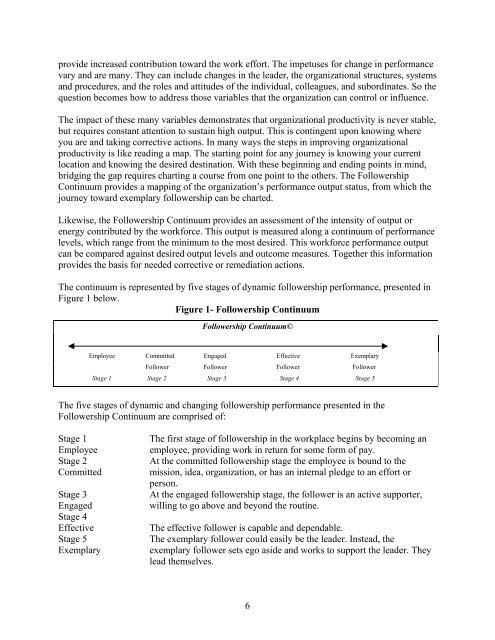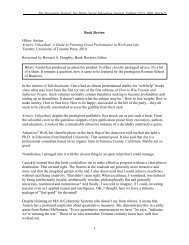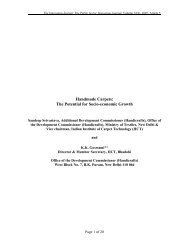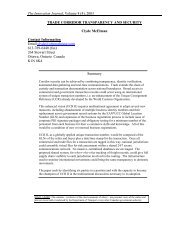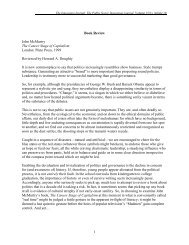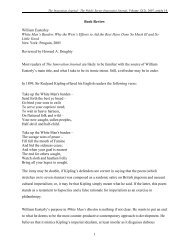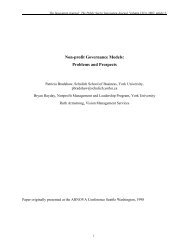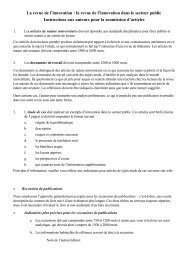The Followership Continuum - The Innovation Journal
The Followership Continuum - The Innovation Journal
The Followership Continuum - The Innovation Journal
You also want an ePaper? Increase the reach of your titles
YUMPU automatically turns print PDFs into web optimized ePapers that Google loves.
provide increased contribution toward the work effort. <strong>The</strong> impetuses for change in performance<br />
vary and are many. <strong>The</strong>y can include changes in the leader, the organizational structures, systems<br />
and procedures, and the roles and attitudes of the individual, colleagues, and subordinates. So the<br />
question becomes how to address those variables that the organization can control or influence.<br />
<strong>The</strong> impact of these many variables demonstrates that organizational productivity is never stable,<br />
but requires constant attention to sustain high output. This is contingent upon knowing where<br />
you are and taking corrective actions. In many ways the steps in improving organizational<br />
productivity is like reading a map. <strong>The</strong> starting point for any journey is knowing your current<br />
location and knowing the desired destination. With these beginning and ending points in mind,<br />
bridging the gap requires charting a course from one point to the others. <strong>The</strong> <strong>Followership</strong><br />
<strong>Continuum</strong> provides a mapping of the organization’s performance output status, from which the<br />
journey toward exemplary followership can be charted.<br />
Likewise, the <strong>Followership</strong> <strong>Continuum</strong> provides an assessment of the intensity of output or<br />
energy contributed by the workforce. This output is measured along a continuum of performance<br />
levels, which range from the minimum to the most desired. This workforce performance output<br />
can be compared against desired output levels and outcome measures. Together this information<br />
provides the basis for needed corrective or remediation actions.<br />
<strong>The</strong> continuum is represented by five stages of dynamic followership performance, presented in<br />
Figure 1 below.<br />
Figure 1- <strong>Followership</strong> <strong>Continuum</strong><br />
<strong>Followership</strong> <strong>Continuum</strong>©<br />
Employee Committed Engaged Effective Exemplary<br />
Follower Follower Follower Follower<br />
Stage 1 Stage 2 Stage 3 Stage 4 Stage 5<br />
<strong>The</strong> five stages of dynamic and changing followership performance presented in the<br />
<strong>Followership</strong> <strong>Continuum</strong> are comprised of:<br />
Stage 1<br />
Employee<br />
Stage 2<br />
Committed<br />
Stage 3<br />
Engaged<br />
Stage 4<br />
Effective<br />
Stage 5<br />
Exemplary<br />
<strong>The</strong> first stage of followership in the workplace begins by becoming an<br />
employee, providing work in return for some form of pay.<br />
At the committed followership stage the employee is bound to the<br />
mission, idea, organization, or has an internal pledge to an effort or<br />
person.<br />
At the engaged followership stage, the follower is an active supporter,<br />
willing to go above and beyond the routine.<br />
<strong>The</strong> effective follower is capable and dependable.<br />
<strong>The</strong> exemplary follower could easily be the leader. Instead, the<br />
exemplary follower sets ego aside and works to support the leader. <strong>The</strong>y<br />
lead themselves.<br />
6


